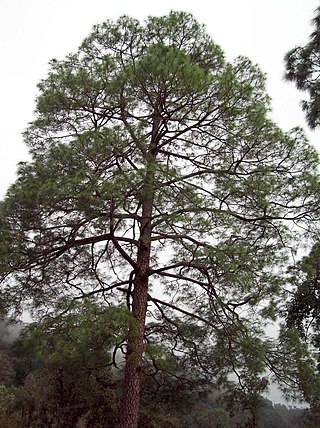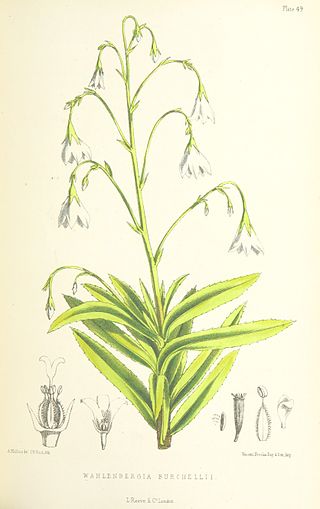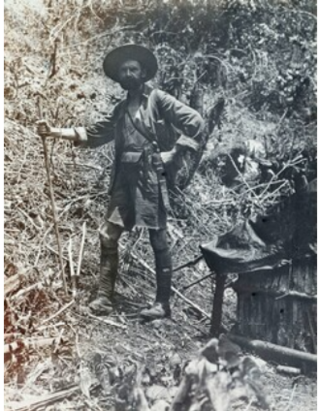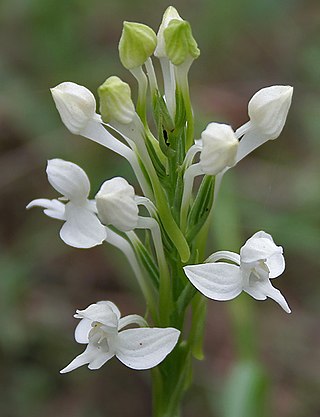
Begonia is a genus of perennial flowering plants in the family Begoniaceae. The genus contains more than 2,000 different plant species. The Begonias are native to moist subtropical and tropical climates. Some species are commonly grown indoors as ornamental houseplants in cooler climates. In cooler climates some species are cultivated outside in summertime for their bright colorful flowers, which have sepals but no petals.

Pinus roxburghii, commonly known as chir pine or longleaf Indian pine, is a species of pine tree native to the Himalayas. It was named after William Roxburgh.

The Government Botanical Garden is a botanical garden in Udhagamandalam, near Coimbatore (Ooty), Tamil Nadu state, India laid out in 1848. The gardens, divided into several sections, cover an area of around 55 acres, and lie on the lower slopes of Doddabetta peak. The garden has a terraced layout. It is maintained by the Tamil Nadu Horticulture Department.

Begoniaceae is a family of flowering plants with two genera and about 2040 species occurring in the subtropics and tropics of both the New World and Old World. All but one of the species are in the genus Begonia. There have been many recent discoveries of species in the genus Begonia, such as Begonia truncatifolia which is endemic to San Vincente, Palawan. B. truncatifolia is smaller in size than other species of the genus Begonia and this new species is proposed Critically Endangered by standards set by the IUCN. The only other genus in the family, Hillebrandia, is endemic to the Hawaiian Islands and has a single species. Phylogenetic work supports Hillebrandia as the sister taxon to the rest of the family. The genus Symbegonia was reduced to a section of Begonia in 2003, as molecular phylogenies had shown it to be derived from within that genus. Members of the genus Begonia are well-known and popular houseplants.

Wahlenbergia roxburghii, the Roxburgh bellflower or dwarf cabbage tree, is an extinct member of a group of four species of Wahlenbergia once known from the island of Saint Helena, in the South Atlantic Ocean. It was last seen by naturalist John Charles Melliss in 1872. William Roxburgh recorded it in the thick forests on the south face of Diana's Peak. De Candolle notes it in dense woods around Diana's Peak and Halley's Mount. Burchell notes it 'On Sandy Bay ridge near Taylor's. Flowering: probably August to March. It was exceedingly rare in Meliss's time, it is not in his book as he had not found it. It was probably the increase of Phormium tenax planting on the ridge that pushed Wahlenbergia roxburghii into final extinction. It is an example of one of the early extinctions of Saint Helena plants as a result of human activity, with a history similar to that of the stringwood, .

The cane begonias are a group of Begonia cultivars. Their name derives from their tough, bamboo-like stems. They can grow up to 10 ft (3.0 m) tall, which may necessitate staking. They are often ideal as houseplants when kept under control.

Cecil Boden Kloss was an English zoologist. He was an expert on the mammals and birds of Southeast Asia. The Rubiaceae genus Klossia was named after him.

Heptapleurum digitatum, is a species of plant in the family Araliaceae. It is native to India, Nepal, Bhutan, and Myanmar.

Begonia grandis, the hardy begonia, is a species of flowering plant in the family Begoniaceae. This herbaceous perennial has alternate, simple leaves on arching stems. The flowers are pink or white, borne in dichotomously branching cymes from late summer through fall in USDA U.S. Hardiness Zone 7. As the common name "hardy begonia" implies, it is winter hardy in some temperate regions.
Richard Pearce was a British plant collector, who introduced the tuberous begonia to England, which led to the development of the hybrid begonias grown today.

Vanda tessellata is a species of orchid occurring from the Indian subcontinent to Indochina. It is a medicinal plant.

Bulbophyllum roxburghii is a species of orchid in the genus Bulbophyllum.

Balanites roxburghii is a spiny, evergreen tree. It is common in open sandy plains of the Indian peninsula, western Rajasthan, west Bengal, Maharashtra, Gujarat and drier parts of India. The specific epithet roxburghii refers to the Scottish botanist William Roxburgh.

Donella lanceolata is a plant species in the family Sapotaceae. It is a tree growing up to 30 metres (100 ft) tall, with a trunk diameter of up to 40 cm (16 in). The bark is grey to dark brown. Inflorescences bear up to 45 flowers. The fruit are brownish to purplish black, ripening yellow, round, up to 4 cm (2 in) in diameter. Its habitat is lowland forests from sea level to 700 metres (2,300 ft) altitude. Its natural range is Madagascar, India, Sri Lanka, Thailand, Cambodia, Laos, Vietnam, Malaysia, Brunei, Indonesia, the Philippines, Papua New Guinea, the Solomon Islands and Queensland.

Cassia roxburghii, the red cassia, Roxburgh's cassia or Ceylon senna, is a flowering plant in the family Fabaceae. The species is native to the Indian subcontinent and adjacent regions of Southeast Asia. It ranges throughout South India and Sri Lanka.

Habenaria roxburghii, commonly known as Roxburgh's habenaria, malle leena gadda and as chekku dumpa in Telugu, is a species of orchid found in southern India. It is a tuberous terrestrial herb, 250–350 mm (10–10 in) tall. There are two or three more or less round leaves, about 70 mm (3 in) long and 50 mm (2 in) wide lying flat on the ground. The flowers pure white are arranged in long, dense cluster up to 80 mm (3 in) long. The sepals are broad egg-shaped, about 8 mm (0.3 in) long and the labellum has three lobes. The middle lobe is 8 mm (0.3 in) long and the side lobes are small. The species is usually found in shady places in the undergrowth of forests and is found in the Eastern Ghats.

Begonia cucullata, also known as clubbed begonia, is a species of the Begoniaceae that is native to South American countries of Argentina, Brazil, Paraguay, and Uruguay. A common garden plant and part of the section Begonia, it was described in 1805 by Carl Ludwig Willdenow (1765–1812). The specific epithet "cucullata" means "resembling a hood" or "hooded".
Danilo Tandang is a Filipino botanist, working in the National Museum of the Philippines, Philippines

Rosa roxburghii,, is a species of flowering plant in the family Rosaceae, native to the eastern Himalayas, Tibet, and central and southern China. In the wild it is found in thickets, mountain forests, on slopes, and alongside streams, typically 500 to 1,400 m above sea level. A diffuse shrub capable of reaching 8 m (26 ft) but usually shorter, it is available from commercial suppliers. In China, it is cultivated for its vitamin C-rich hips on 170,000 ha, mostly in Guizhou.
















